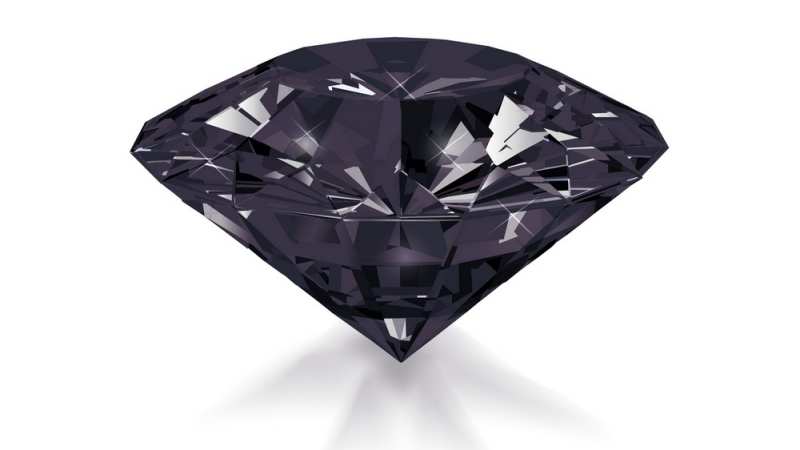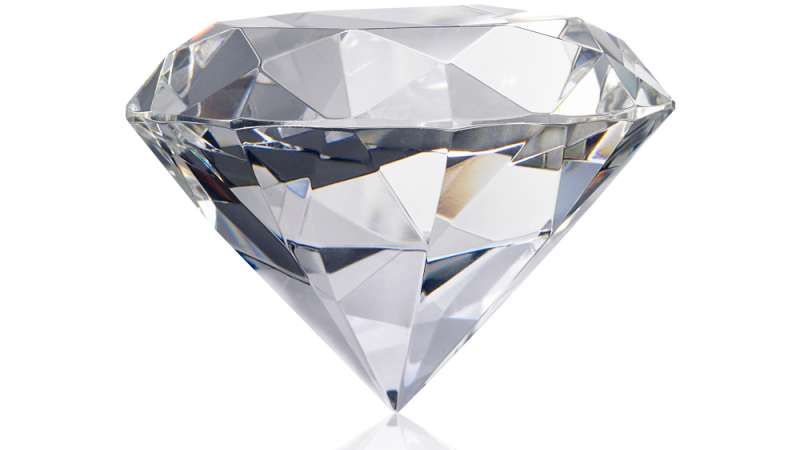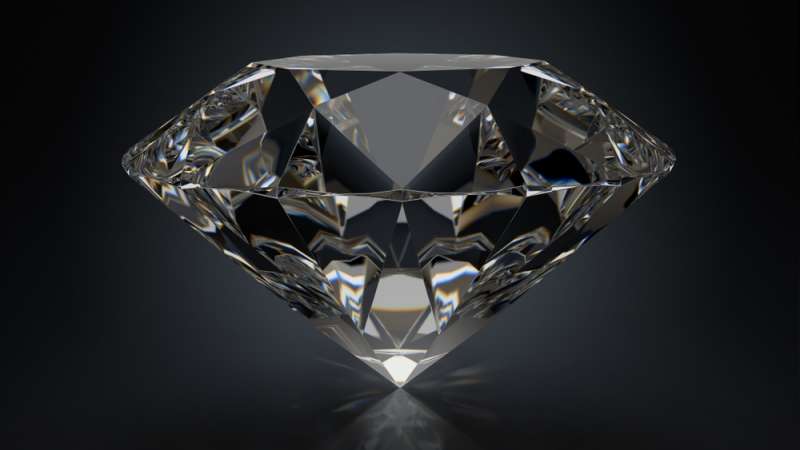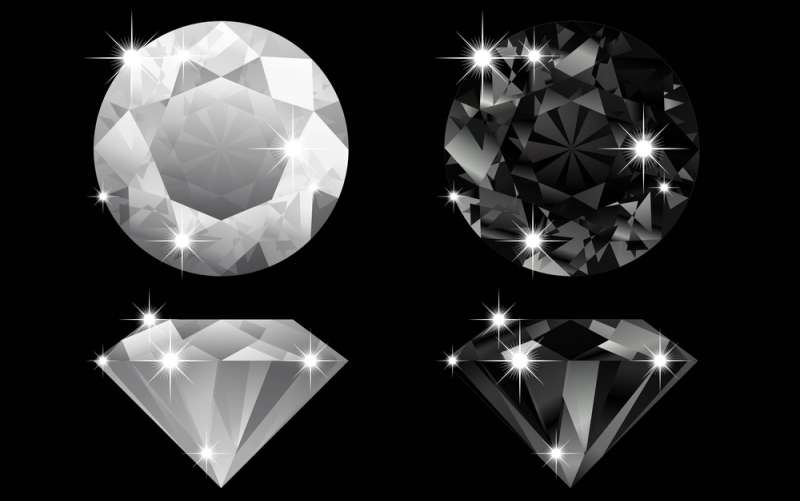When it comes to shopping for diamonds, it’s common for most people to immediately focus on white diamonds. White diamonds are the most popular choice and are often considered the standard for engagement rings and other jewelry.
However, it’s important to note that diamond merchants offer more than just white diamonds. In recent years, there has been an increasing demand for black diamonds as customers appreciate the striking and dramatic appearance they bring.
To assist you in making an informed decision, we will compare the key characteristics, such as structure, pricing, shapes, durability, and other factors, of black diamonds and white diamonds. By understanding these aspects, you can determine which type of diamond is most suitable for you.
DESIGN YOUR OWN ENGAGEMENT RING: START WITH A SETTING OR START WITH A DIAMOND. IT’S REALLY UP TO YOU!

What Are Black Diamonds?
Black diamonds acquire their black appearance due to the numerous inclusions present within the gem. Inclusions, which manifest as dark spots within the diamond, are common in white diamonds. However, when these inclusions cover the entire diamond, it results in a black coloration.
Black diamonds fall under the category of fancy colored diamonds, which also includes blue, yellow, and pink diamonds. While black diamonds have a distinct appearance from colorless diamonds, they are still genuine diamonds.
There are two types of black diamonds. The first type is natural black diamonds, which undergo a transformation from white to black during their formation process. These diamonds contain abundant mineral inclusions such as graphite, pyrite, and hematite, which extend throughout the gemstone, giving it a metallic appearance. Natural black diamonds are rare and command high prices due to their untouched nature.
The second type is treated black diamonds. These diamonds are originally white diamonds that have been artificially infused with stains and impurities to achieve a black hue. Through a low-pressure, high-temperature treatment, the white diamonds are altered. Treated black diamonds are of lower grade compared to natural black diamonds. However, they are becoming rarer as treatment methods and their usage in cocktail jewelry have decreased their availability.
Treated black diamonds are significantly more affordable than naturally occurring black diamonds from the earth.

What Are White Diamonds?
White diamonds appear colorless due to the absence of inclusions within their crystal structure. These diamonds are considered a timeless choice, and the most valuable ones are naturally colorless.
As you move down the GIA color rating scale from D (colorless) to Z, you will notice increasing undertones of yellow or brown, reaching a point where the diamond is no longer classified as white. The majority of diamonds mined fall into the white category, and the diamond’s color grade is determined by the presence and type of inclusions.
Even if a white diamond contains black particles distributed throughout its structure, it is still classified as a colorless gem, regardless of its origin. However, it may receive a lower grade on the GIA clarity scale due to the presence of these inclusions.

Contrasting Black And White Diamonds
When it comes to choosing between a black diamond and a white diamond, it’s important to consider various factors before making a purchase. While they may share some similarities, black and white diamonds offer distinct appearances and designs that may suit different preferences.
Origin
White diamonds can be found in various parts of the world, with certain regions like Australia, Asia, South Africa, and South America being more abundant in white diamond deposits. The demand and price for high-quality white diamonds remain high, as many of them are small and include inclusions. The Argyle Mine in Australia is renowned as the world’s primary source of white diamonds.
Contrary to popular belief, black diamonds are not commonly found in traditional diamond-mining regions. Most discoveries of black diamonds come from Brazil and Central Africa, making them relatively rare and valuable. Treated black diamonds, on the other hand, can be obtained from any location as long as the base material is a white diamond with imperfections.
Structure
Both black and white diamonds are formed through high pressure on carbon deep within the Earth’s surface. They are then transported to the surface through volcanic activity and subsequently mined. However, the structure of black diamonds includes a graphite inclusion that white diamonds lack. Some black diamonds are even believed to have fallen to Earth as meteorites. Black diamonds can also feature white or gray inclusions, adding to their uniqueness. Due to their crystal structure, black diamonds absorb most of the light that enters them, while white diamonds reflect light in a brilliant manner based on the quality of their cut.
Color
The most noticeable difference between black and white diamonds is their color. White diamonds are graded on the GIA scale, ranging from completely colorless to having noticeable yellow or brown undertones. Black diamonds, however, do not follow the traditional grading criteria used for white diamonds. They exist solely in a fancy black color, with variations in intensity such as fancy light, fancy dark, or fancy deep. While black diamonds do not receive intensity grades, they can have different tones, and personal preference plays a role in choosing the desired hue.
Clarity
Black diamonds are typically more included than white diamonds, making direct clarity comparisons challenging. However, it’s still important to assess the clarity of a black diamond and ensure there are no visible flaws that detract from the desired black color. In white diamonds, clarity is graded by the GIA, with a lower grade indicating a higher prevalence of inclusions. For an eye-clean stone, an SI1 clarity grade is generally recommended.
Durability
Durability should also be considered when comparing black and white diamonds. Natural black diamonds with imperfections are generally less durable than their white counterparts due to the presence of inclusions that can create weak spots. Diamond cutters need to exercise extra caution when working with black diamonds. However, both black and white diamonds rank a perfect 10 on the Mohs scale of hardness, indicating high durability. It’s important to protect both types of diamonds from significant pressure by setting them securely.
Light Performance
White diamonds are known for their ability to reflect light and create dazzling sparkle. The cut of a white diamond is crucial in maximizing its light performance. In contrast, black diamonds absorb light due to their crystal composition and inclusions, resulting in a unique appearance. White diamonds with excellent cuts can exhibit brilliant sparkle, while black diamonds have a different light performance due to their absorption of light.
Shape
The shape options for black and white diamonds are the same since lasers are commonly used to shape rough diamonds. Popular shapes include round, pear, cushion, Princess, Asscher, and oval. The choice of shape depends on personal preference.
Settings
Both black and white diamonds can be set in various ways. Common choices for black diamonds include three-stone and halo settings, while prong and solitaire settings are popular

Conclusion
In conclusion, when comparing black diamonds and white diamonds, it’s important to consider all the relevant factors before making a decision. While white diamonds are more popular, don’t feel confined to the traditional choice. Black diamonds offer rarity, elegance, and a symbol of wealth.
Take into account the distinctions in clarity, structure, light performance, and certifications between the two types. Begin your search at a reputable diamond store that provides a reliable certification report.
The key aspect of purchasing either a black or white diamond is ensuring that the quality matches the price. Once you find the perfect diamond, you can wear it proudly for years to come.


